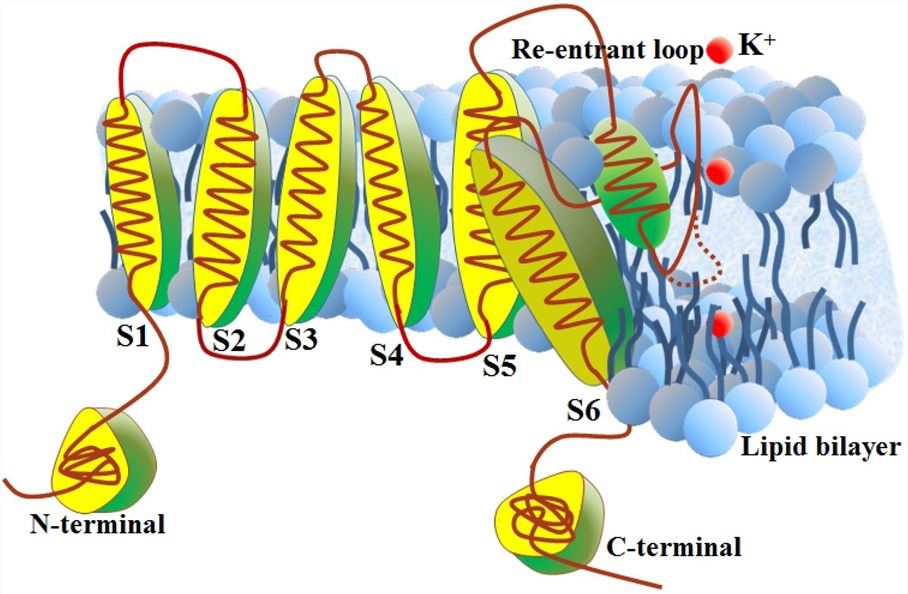Introduction of KCNB1
KCNB1, also known as Kv2.1, is a member of the potassium channel, voltage-gated, shab-related subfamily. It is encoded by the KCNB1 gene and has 858 amino acid residues. The structure analysis of KCNB1 indicates that it has 6 transmembrane spanning regions labeled S1-S6, each with a tetrameric structure. The p-loop is created by S5 and S6. The S4 contains a voltage sensor. KCNB1 is expressed in the nervous system, heart, skeletal muscle, pulmonary arteries, and pancreas.
| Basic Information of KCNB1 | |
| Protein Name | Potassium voltage-gated channel subfamily B member 1 |
| Gene Name | KCNB1 |
| Aliases | DRK1, Kv2.1 |
| Organism | Homo sapiens (Human) |
| UniProt ID | Q14721 |
| Transmembrane Times | 6 |
| Length (aa) | 858 |
| Sequence | MPAGMTKHGSRSTSSLPPEPMEIVRSKACSRRVRLNVGGLAHEVLWRTLDRLPRTRLGKLRDCNTHDSLLEVCDDYSLDDNEYFFDRHPGAFTSILNFYRTGRLHMMEEMCALSFSQELDYWGIDEIYLESCCQARYHQKKEQMNEELKREAETLREREGEEFDNTCCAEKRKKLWDLLEKPNSSVAAKILAIISIMFIVLSTIALSLNTLPELQSLDEFGQSTDNPQLAHVEAVCIAWFTMEYLLRFLSSPKKWKFFKGPLNAIDLLAILPYYVTIFLTESNKSVLQFQNVRRVVQIFRIMRILRILKLARHSTGLQSLGFTLRRSYNELGLLILFLAMGIMIFSSLVFFAEKDEDDTKFKSIPASFWWATITMTTVGYGDIYPKTLLGKIVGGLCCIAGVLVIALPIPIIVNNFSEFYKEQKRQEKAIKRREALERAKRNGSIVSMNMKDAFARSIEMMDIVVEKNGENMGKKDKVQDNHLSPNKWKWTKRTLSETSSSKSFETKEQGSPEKARSSSSPQHLNVQQLEDMYNKMAKTQSQPILNTKESAAQSKPKEELEMESIPSPVAPLPTRTEGVIDMRSMSSIDSFISCATDFPEATRFSHSPLTSLPSKTGGSTAPEVGWRGALGASGGRFVEANPSPDASQHSSFFIESPKSSMKTNNPLKLRALKVNFMEGDPSPLLPVLGMYHDPLRNRGSAAAAVAGLECATLLDKAVLSPESSIYTTASAKTPPRSPEKHTAIAFNFEAGVHQYIDADTDDEGQLLYSVDSSPPKSLPGSTSPKFSTGTRSEKNHFESSPLPTSPKFLRQNCIYSTEALTGKGPSGQEKCKLENHISPDVRVLPGGGAHGSTRDQSI |
Function of KCNB1 Membrane Protein
KCNB1 is a delayed rectifier voltage-gated potassium channel which plays an essential role in the falling phase of physiological action potentials. KCNB1 has been reported to exert an essential role in regulating neuronal membrane potential and in stimulation action potential production and firing. KCNB1 is involved in several physiological functions through regulation and propagation of potassium current. In the CNS neurons, KCNB1 regulates neuronal excitability, the duration of action potential, and tonic spiking through mediating delayed rectifier potassium current. In cardiomyocytes, KCNB1 may regulate the duration of both the action potential of cardiomyocytes and the QT interval of heart ventricular repolarization. The inhibition of KCNB1 in mouse ventricular cardiomyocytes causes prolonged action potentials and the QT interval. In human pancreatic beta cells, KCNB1 mediates the cells action potential through regulating potassium efflux thereby participating in the regulation of calcium influx and insulin secretion. Moreover, KCNB1 can promote neuronal cells apoptosis in response to the oxidative injury induced by an increase in reactive oxygen species (ROS).
 Fig.1 Schematic representation of potassium (K+) channel subunit. (Liu, 2014)
Fig.1 Schematic representation of potassium (K+) channel subunit. (Liu, 2014)
Application of KCNB1 Membrane Protein in Literature
The study identifies a novel variant c.595A>Tin KCNB1 in a neurodevelopmental disorder including epilepsy. And the degree of KCNB1 protein dysfunction may affect the severity of the disease.
The research identifies a novel de novo missense (c.1132G>C, p.V378L) mutation of KCNB1 in a patient with whole developmental delay, intellectual retardation, impaired language ability, but no performance of epilepsy until the age of 6 years old.
The study shows that the missense or loss-of-function variants in KCNB1 are associated with neurodevelopmental disorders with or without epilepsy.
The study shows that KCNB1 oxidation may contribute to integrin clustering, promoting the focal adhesion kinase (FAK) and Src/Fyn kinases recruitment and activation.
The study reveals that KCNB1 can be regarded as a new glioma prognostic factor and it can suppress tumor via autophagy induction.
KCNB1 Preparation Options
To obtain the soluble and functional target protein, the versatile Magic™ membrane protein production platform in Creative Biolabs enables many flexible options, from which you can always find a better match for your particular project. Aided by our versatile Magic™ anti-membrane protein antibody discovery platform, we also provide customized anti-KCNB1 antibody development services.
As a forward-looking research institute as well as a leading custom service provider in the field of membrane protein, Creative Biolabs has won good reputation among our worldwide customers for successfully accomplishing numerous challenging projects including generation of many functional membrane proteins. Please feel free to contact us for more information.
Reference
All listed services and products are For Research Use Only. Do Not use in any diagnostic or therapeutic applications.